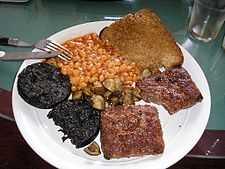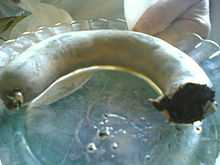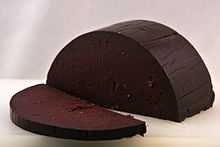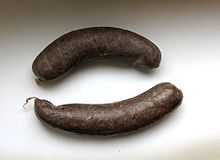Black pudding
|
||||||||||||||||||||||||||||||||||||||||||
Black pudding, blood pudding or blood sausage is a type of sausage made by cooking blood or dried blood with a filler until it is thick enough to congeal when cooled. The dish exists in various cultures from Asia to Europe and the Americas. Pig, cattle, sheep, duck, and goat blood can be used depending on different countries.
In Europe and the Americas, typical fillers include meat, fat, suet, bread, cornmeal, sweet potato,[citation needed] onion, chestnuts, barley, and oatmeal. In Spain, Portugal and Asia, potato is often replaced by rice.
Asia



Across Asia, various people create food from congealed animal blood. Most of these food types do not have casing and might be considered a version of sliced sausage.
China
In the Chinese cultures, whole coagulated blood is fried or steamed as a snack or cooked in a hot pot. In Mainland China, "blood tofu" (Chinese: 血豆腐; pinyin: xuě dòufǔ), or "red tofu" (Chinese: 红豆腐; pinyin: hóng dòufǔ), is most often made with pig's or duck's blood, although chicken's or cow's blood may also be used. Like the above dishes, this has no casing but is simply cut into rectangular pieces and cooked. In the Northeast China, the "blood sausage" is a traditional food which is cooked with sheep or goat blood. In resource-poor Tibet, congealed yak's blood is a traditional food.[1][2] In Hong Kong, the dish is only made with pig's blood and simply called "pig red" (Chinese: 豬紅). Blood sausage is popular in Mongolia. In Mongolia a special method of killing sheep was made mandatory by Genghis Khan to save blood for sausage. It appears in the Yasa and is still used today.
Taiwan
In Taiwan, pig's blood cake (Chinese: 豬血糕; pinyin: zhū xuě gāo), made of pork blood and sticky rice is served on a popsicle stick is a very popular snack at local night markets in Taiwan.
Malaysia
In Penang or other northern states, "pig red" (Chinese: 猪红; pinyin: zhū hóng) is sometimes served with their traditional dish, "laksa" or curry noodles. It can also be mixed with some traditional Hokkien dishes as well.
Tibet
In Tibetan cuisine, sausages or "gyurma" refer to blood sausages and are made with yak or sheep's blood which may or may not include either rice or roasted barley flour as filler. The sausage uses natural casing employing the use of yak or sheep's intestine.
Philippines
A similar dish from the Philippines, dinuguan (pork-blood stew, from the word dugo meaning "blood") is a stew consisting of diced beef or pork and organs with pork or beef blood simmered in a rich, spicy gravy of blood, salt, pepper, spices, garlic, onions, hot chili and vinegar. Because the stew is thick and dark, the euphemism "chocolate meat" was coined. Dinuguan is often served with white rice or a Philippine rice cake called puto. It has regional names and varieties.
Similar to dinuguan, pinuneg or penuneng is a native blood sausage composed of minced pork and innards prepared in the Cordillera Region of the Philippines. Another similar dish is the popular "Betamax", pieces of grilled coagulated chicken or pork blood sold in streets across the country, named for its resemblance to the video recording storage medium created by Sony.
Java
This dish, dinuguan, is also known in Java as saren, which is made with chicken's or pig's blood.
Vietnam
Vietnamese 'dồi tiết' (Northern) or 'dồi huyết' (Southern) is blood sausage, boiled or fried, made with pork blood, pork fat, basil.
Thailand
In Thai cuisine sai krok lueat (Thai: ไส้กรอกเลือด) is a blood sausage (Thai: sai krok = sausage, Thai: lueat = blood), often served sliced and accompanied by a spicy dipping sauce. "Blood tofu" is simply called lueat (Thai: เลือด, blood) in Thailand. This can be used in many Thai dishes such as in noodle soups, Thai curries, or as an addition to certain rice dishes such as Khao man kai.
Korea
The majority of Korea's sundae (순대) can be categorised as blood sausage. The most common type of soondae is made of potato noodle (dangmyeon), barley, and pig's blood but some variants contain sesame leaves, green onion, fermented soy paste (doenjang), sweet rice, kimchi, bean sprouts, in addition to the common ingredients.
Europe
United Kingdom and Ireland


Black pudding in the United Kingdom and Ireland is generally made from pork blood and a relatively high proportion of oatmeal. In the past it was occasionally flavoured with pennyroyal, differing from continental European versions in its relatively limited range of ingredients and reliance on oatmeal and barley instead of onions to absorb the blood.[3] It can be eaten cold, as it is cooked in production, but is often grilled, fried or boiled in its skin.
In the United Kingdom,[4] black pudding is considered a delicacy in the Black Country, Stornoway and the North West, especially in Lancashire, in particular the towns of Bury and Ramsbottom, home of The World Black Pudding Throwing Championships, where it is sometimes boiled and served with malt vinegar out of paper wrapping.[5]
Black puddings are also served sliced and fried or grilled as part of a traditional full breakfast in much of the UK and Republic of Ireland, a tradition that followed British and Irish emigrants around the world. Black pudding is now part of the local cuisine of New Zealand and the Canadian provinces of Nova Scotia and Newfoundland and Labrador.
The similar white pudding is a further important feature of the traditional Northumbrian, Scottish, Irish and Newfoundland breakfast. Black and white pudding, as well as a third variant, red pudding, is served battered in some chip shops in England, Scotland and Ireland as an alternative to fish and chips.
While "blood sausage" in English is understood in Britain, the term is applied only to foreign usage (e.g. in the story The Name-Day by Saki), or to similar blood-based sausages elsewhere in the world.
Germany and Austria

The most common variant of German Blutwurst is made from pork rind, pork blood and regionally different fillers such as barley. Though already cooked and "ready to eat" it is sometimes served warm, similar to the usage in France. In the Rhineland, where it is also traditionally made from horse meat, fried Blutwurst is a constituent of various dishes. In particular in Cologne, the traditional Himmel und Erde (Heaven and Earth) combines apple sauce, mashed potatoes and Blutwurst served hot on one plate. In Berlin, hot Blutwurst mixed together with liverwurst and potatoes is called "Tote Oma" ("Dead Grandma").
Other German variants are Zungenwurst, which is Blutwurst mixed with pieces of pickled ox tongue, and Beutelwurst which is pressed in a linen or paper bag (Beutel). A variety of Blutwurst, the Rotwurst from Thuringia (Thüringer Rotwurst) has geographical indication protection under EU law, with PGI status. Kartoffelwurst (potato sausage) is a post-World War II variety popular in the Palatinate, a reduced fat version of Blutwurst using potato cubes instead of bacon.
In Austria it is often prepared in a dish known as Blunzngröstl, which consists of pan-fried potatoes and blood sausage. This is usually served with freshly grated horseradish.
France
In France, boudin is traditionally prepared in charcuteries, shops that prepare mainly pork products (and sometimes duck and game), but also sell smoked and dried sausages, pâtés, and terrines, along with prepared salads. It is usually called boudin noir, is often made with cream and has apples or onions as a filler. It is generally served with either cooked apples, mashed potatoes or both, and is appreciated by combining either the apples or mashed potatoes with each bite of boudin, which has been gently heated and browned in butter. In France also, there are many regional different Boudins Noirs' such as the large 'Boudin du Béarn with pork meat pieces eaten usually cold. The French Confrérie des Chevaliers du Goûte Boudin (Brotherhood of the Knights of Blood Sausage Tasting) in Mortagne-au-Perche in southern Normandy holds an annual contest of international blood sausage specialities.
Belgium
In Belgium and the Netherlands, bloedworst or beuling is sold either in 4-inch-diameter (100 mm) slices, or individual sausages the size of a banana. It is generally pan fried; sometimes apples are cooked alongside or on top of the pieces. It is also eaten with apple sauce, brown sugar or syrup. As a cold cut, thin slices are eaten as a sandwich topping. Green cabbage is one of the ingredients in Luxembourg's träipen which are also served pan fried with apple sauce.
Estonia
In Estonia, verivorst (blood sausage) is very similar to Finnish mustamakkara. It is sold and eaten mostly in winter, being a traditional Christmas food. At that time there is a large variety of verivorst in stores, ranging in different shapes and sizes. Verivorst is usually cooked in an oven, but sometimes also fried in a pan. Like in Finland, verivorst is often eaten together with lingonberry jam, but occasionally also with butter or sour cream. Another similar dish is called verikäkk (blood dumpling). Its popularity has decreased during the past decades (possibly because of its less appealing commercial appearance) and has mostly been substituted by verivorst.
Italy

In Italy, regional varieties of black puddings are known as 'sanguinaccio'. In Tuscany, buristo is a sausage made with pig's blood and fat cooked in a pig's stomach. It is not reheated and is often spread on bread. It is found only in the south of Tuscany in the winter months and even there it can be difficult to come by. Biroldo is another type of black pudding which can be found in Italy.
Migliaccio[6] is a black pudding that was traditionally prepared in winter in Romagna. It is a sweet pudding with a thick black filling made with pig's blood, sugar, breadcrumbs, almonds, chocolate, butter and spices contained in a thin pastry crust.
Portugal

In Portuguese cuisine, there are many varieties of black pudding. Sausages made of blood are usually called morcela or negrinha (a slang term from Portuguese negro meaning dark or black). There are many varieties around the Portuguese world. There are varieties local to Portugal, the Azores, Hawaii, China, US and India, etc.
Spain

Spanish morcilla has many variants. The most well-known and widespread is morcilla de Burgos which contains mainly pork blood and fat, rice, onions, and salt. In Albacete and La Mancha, the morcilla is filled with onions instead of rice, which completely changes the texture. In Extremadura the creamy morcilla patatera includes roughly mashed potatoes. In the northern regions and the Canary Islands there is a sweet variety known as morcilla dulce. Other varieties introduce breadcrumbs, pine nuts, and almonds, and vary the proportions of the other ingredients or flavourings, some of them considered delicacies.
Netherlands
In the Netherlands black pudding is called "bloedworst", It is known to have been eaten in church in the Middle Ages during carnival in the Netherlands
Nordic countries
Denmark
In Denmark, blodpølse is made from pigs's blood and suet, rye flour, brown sugar, raisins, salt, cinnamon and cardemon stuffed into natural or artificial intestines. It is usually boiled in its skin, eaten hot or cold, sometimes sliced and fried, served with syrup, cinnamon and stewed apples.
Iceland
In Iceland, blóðmör is one of two types of slátur. It is made from lamb's blood and suet, rye flour and oats, traditionally stuffed into pouches sewn from the lamb's stomach. It is usually boiled in its skin, eaten hot or cold, sometimes sliced and fried. After cooking, it is often preserved in fermented whey and acquires a distinct sour taste.
Finland
Alongside the mustamakkara (black sausage) in Finland, a dish similar to black pudding is made by making batter out of pig's blood and baking it like pancakes. Traditionally, rye flour or oatmeal is used and minced onion is added to the mix. This dish is called veriohukainen (blood pancake – crepe-style in contrast to Finnish pancake which is baked in an oven). It is similar to the Swedish dish blodplättar below, and is alternatively called verilettu or verilätty using a Finland-Swedish term for pancakes instead of a native Finnish one. Rössypottu is a traditional soup in northern Finland with blood pudding as a main ingredient.
Sweden


Blodpudding is a traditional medieval dish still popular in Sweden. The exact proportions and ingredients varies from recipe to recipe as well as regional preference but generally the batter is made out of pig's blood, milk, rye or barley flour, diced lard, either beer or svagdricka, treacle and onion, flavoured with allspice and marjoram. It is then poured into forms and oven-baked in a waterbath. Most of the blodpudding consumed today is made on industrial basis. When prepared for serving, it is sliced and fried. The style of serving and accompaniments vary across the country, and it its not uncommon to have the blodpudding act as the meat in the dish served. Nationally, the common way is to serve it with lingonberry jam, grated carrots and ice cold milk to drink. Fried bacon or porkside is also common. In Scania, the lingonberry jam is often replaced by finely sliced apples, fried along with the pork.
Other blood-based foods include blodkorv (blood sausage) which differs from blodpudding by having raisins, pork tallow and apple sauce in it, blodplättar (blood pancakes) and blodpalt. There is also a soup made from blood, called svartsoppa (black soup).
Eastern Europe
Throughout Eastern Europe, blood sausage, known as kishka (meaning "intestine"), is made with pig's blood and buckwheat kasha. It is also known in Russia as krovyanka (кровянка), or krovyanaya kolbasa (кровяная колбаса, literally "blood sausage"), and include buckwheat as a main filler, instead of oats or oatmeal. In Ukraine it's called krov'yanka (кров'янка) or kryvava kyshka (кривава кишка), kiszka or kaszanka in Poland, and krupniok in Silesia. Polish salceson ("black" and "Brunszwicki") are a type of head cheese that contains blood. In Hungary, véres hurka is made with rice, pig's blood and pork. In Bulgaria, karvavitsa (кървавица) is usually prepared with pig's blood, fat and a variety of mountain herbs and spices and eaten warm during the winter. A similar blood sausage, called krvavica, is also eaten in Bosnia, Croatia, Serbia, and Slovenia.
In Romania, the traditional sângerete (from sânge, "blood" in Romanian) is made from shoulder butt pork meat, pork blood and a filler such as pre-boiled rice seasoned with pepper, garlic and basil. It has many regional variants, but the most common are the sângerete from Transylvania.
Similarly, in Czech cuisine, jelito is made from second-rate pork, pig's blood and peeled barley; the stuffing served by itself, unformed, is called prejt.
Additional varieties
Other varieties of blood sausage include blodpølse (Norway and Denmark), tongeworst (with added pigs tongues) (Netherlands), mazzit (Malta), krvavica (Balkans), krovianka (Russia and Ukraine), vedarai (Lithuania)
The Americas
United States
Blood sausages are very difficult to find in American supermarkets, and are often made at home [citation needed], especially by the older generations. Brussels, Wisconsin and Sturgeon Bay are all home to local grocers who produce blood sausage, due to their large Belgian American populations. Supermarkets throughout Maine also carry locally produced blood pudding due to the state's large French Canadian population. In southeastern Michigan, Polish-style Kaszanka can be found in supermarkets throughout the year and is very popular.
An Italian-American version of black pudding in the San Francisco Bay area is called biroldo and has pine nuts, raisins, spices, pig snouts and is made using either pig's or cow's blood.
Cajun boudin is a fresh sausage made with green onions, pork, pork liver (making it somewhat gritty/grainy), and rice. Pig's blood was sometimes added to produce boudin rouge, but this tradition became increasingly rare after the mid-twentieth century due to the decline of the boucherie (traditional communal butchering) and government health regulations prohibiting the transportation of raw blood. As a result, Cajun boudin is now usually made without blood; however, blood or "black" boudin can still be purchased.
Latin America
In many areas of Latin America, morcilla is served. Morcilla is sometimes made with a filler of rice and/or onions, and seasoned with paprika and other spices. In Puerto Rico, it is served fried and mostly consumed during the holidays. In some countries of South America, morcilla is a component of the asado, a regional mixed grill or barbecue meal. In Colombia, morcilla is often served with parrilla (barbecue). Morcilla is also eaten inside a sandwich called "morcipán," especially in the Río de la Plata. In Uruguay, a sweet version including raisins and pine nuts is popular, some vendors even add chocolate, caramelised orange peels, peanuts, and other dried fruits. Uruguayans usually are fond of sweet or salty morcilla, and most restaurants and supermarkets carry both versions.
Chile
In Chile, the blood sausage is called "prieta" (a synonym of "negra", black) and tends to have a very thick skin, so is eaten cut open lengthwise. Apart from blood and a little fat, "prietas" may contain a variety of ingredients, such as chopped onion and spices, cabbage, peppers, watercress, rice, meat or even dried fruit or nuts. "Prietas" or "morcillas" are part of the Chilote tradition of "reitimiento" involving the slaughter and preparation of a pig.
Ecuador
In Ecuador the blood sausage is also called morcilla, while in Panama and Colombia, it is called morcilla, rellena or tubería negra, and is usually filled with rice. In Brazil, as in Portugal, morcela and chouriço de sangue are eaten. In El Salvador, Nicaragua and Mexico, it is called "moronga".
The Caribbean
In Antigua, rice pudding is a local delicacy and it is prepared the same way as black pudding. In the French Antilles, boudin antillais is very popular, this being the French boudin noir with local Caribbean chilli and other spices.
In Barbados, black pudding is made with sweet potato (batata), pig's blood and onions, seasoned with peppers and other herbs and stuffed in pig intestines. It is normally served with souse, which is pickled pig's feet, pig's ears and other trimmings. The cooked meat is cut into bite-sized pieces and soaked in a brine made of water, lime juice, cucumbers, hot pepper, and specially prepared seasonings. Black pudding and souse is a Bajan delicacy usually prepared on weekends and special occasions.
In Guyana, black pudding is a very popular snack served at social occasions, and as "cutters" when drinking. The main ingredient is cooked rice seasoned with herbs, such as thyme and basil. The rice is mixed with cow's blood, stuffed into cow's or pig's intestine, and boiled until firm, sliced and served with Sour (a mild type of dipping sauce with hot peppers). White pudding is also made.
In Suriname, black pudding is known by the Dutch name bloedworst, and white pudding by the also Dutch name vleesworst.
In Trinidad & Tobago, a version of black pudding heavily seasoned with local peppers is traditionally prepared from pig's blood, often substituted by pig's liver today. It is sold by local producers as a popular accompaniment to rolls of crusty hops bread or served as an accompaniment to trotter souse, a stew based on trotters.[7]
Other varieties of blood sausage include boudin rouge (Creole and Cajun), rellena or moronga (Mexico) and sanganel (Friuli).
See also
References
- ↑ Ma Jian, Stick Out Your Tongue Chatto and Windus London, 2006.
- ↑ Uses of yak blood in Tibet. Retrieved on 9 May 2009.
- ↑ Jaine, T. and Davidson, A. The Oxford companion to food, OUP, 2006, p.104
- ↑ "The Black Pudding". The English Breakfast Society. Retrieved 2014-01-06.
- ↑ Lancashire and Cheshire Regional Dishes, accessed 30 April 2010
- ↑ "La scienza in cucina e l'Arte di mangiar bene" by Pellegrino Artusi; recipe n. 702
- ↑ Dave DeWitt & Mary Jane Wilson: Callaloo, Calypso & Carnival, p.62. The Crossing Press 1993
External links
| Wikimedia Commons has media related to Black pudding. |
- The Black Pudding. A history and guide by The English Breakfast Society.
- Black pudding recipe from uktv food
| |||||||||||||||||||||||||||
| ||||||||




